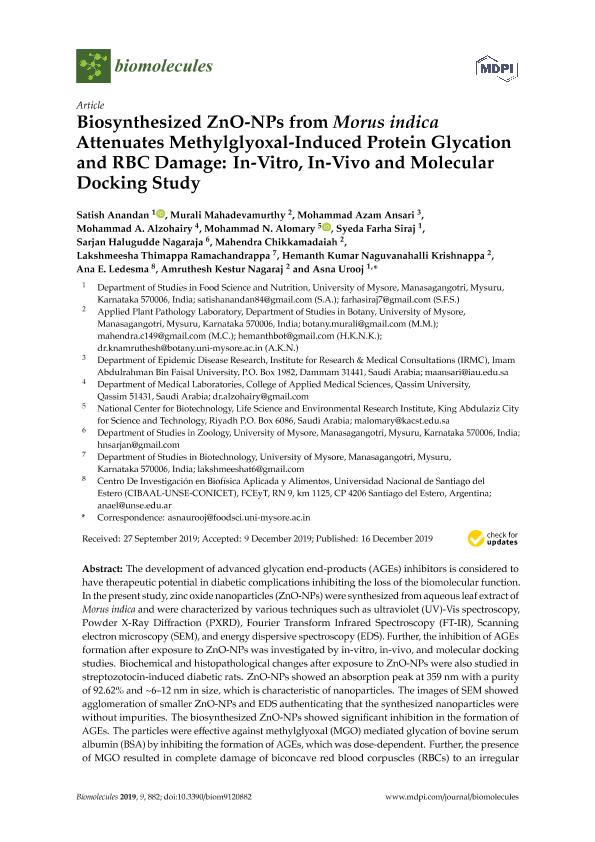Mostrar el registro sencillo del ítem
dc.contributor.author
Anandan, Satish
dc.contributor.author
Mahadevamurthy, Murali
dc.contributor.author
Ansari, Mohammad Azam
dc.contributor.author
Alzohairy, Mohammad A.
dc.contributor.author
Alomary, Mohammad N.
dc.contributor.author
Siraj, Syeda Farha
dc.contributor.author
Nagaraja, Sarjan Halugudde
dc.contributor.author
Chikkamadaiah, Mahendra
dc.contributor.author
Ramachandrappa, Lakshmeesha Thimappa
dc.contributor.author
Krishnappa, Hemanth Kumar Naguvanahalli
dc.contributor.author
Ledesma, Ana Estela

dc.contributor.author
Nagaraj, Amruthesh Kestur
dc.contributor.author
Urooj, Asna
dc.date.available
2021-11-30T05:36:38Z
dc.date.issued
2019-12
dc.identifier.citation
Anandan, Satish; Mahadevamurthy, Murali; Ansari, Mohammad Azam; Alzohairy, Mohammad A.; Alomary, Mohammad N.; et al.; Biosynthesized ZnO-NPs from Morus indica attenuates methylglyoxal-induced protein glycation and RBC damage: In-vitro, in-vivo and molecular docking study; Multidisciplinary Digital Publishing Institute; Biomolecules; 9; 12; 12-2019; 1-19
dc.identifier.issn
2218-273X
dc.identifier.uri
http://hdl.handle.net/11336/147664
dc.description.abstract
The development of advanced glycation end-products (AGEs) inhibitors is considered to have therapeutic potential in diabetic complications inhibiting the loss of the biomolecular function. In the present study, zinc oxide nanoparticles (ZnO-NPs) were synthesized from aqueous leaf extract of Morus indica and were characterized by various techniques such as ultraviolet (UV)-Vis spectroscopy, Powder X-Ray Diffraction (PXRD), Fourier Transform Infrared Spectroscopy (FT-IR), Scanning electron microscopy (SEM), and energy dispersive spectroscopy (EDS). Further, the inhibition of AGEs formation after exposure to ZnO-NPs was investigated by in-vitro, in-vivo, and molecular docking studies. Biochemical and histopathological changes after exposure to ZnO-NPs were also studied in streptozotocin-induced diabetic rats. ZnO-NPs showed an absorption peak at 359 nm with a purity of 92.62% and ~6–12 nm in size, which is characteristic of nanoparticles. The images of SEM showed agglomeration of smaller ZnO-NPs and EDS authenticating that the synthesized nanoparticles were without impurities. The biosynthesized ZnO-NPs showed significant inhibition in the formation of AGEs. The particles were effective against methylglyoxal (MGO) mediated glycation of bovine serum albumin (BSA) by inhibiting the formation of AGEs, which was dose-dependent. Further, the presence of MGO resulted in complete damage of biconcave red blood corpuscles (RBCs) to an irregular shape, whereas the morphological changes were prevented when they were treated with ZnO-NPs leading to the prevention of complications caused due to glycation. The administration of ZnO-NPs (100 mg Kg−1) in streptozotocin(STZ)-induced diabetic rats reversed hyperglycemia and significantly improved hepatic enzymes level and renal functionality, also the histopathological studies revealed restoration of kidney and liver damage nearer to normal conditions. Molecular docking of BSA with ZnO-NPs confirms that masking of lysine and arginine residues is one of the possible mechanisms responsible for the potent antiglycation activity of ZnO-NPs. The findings strongly suggest scope for exploring the therapeutic potential of diabetes-related complications.
dc.format
application/pdf
dc.language.iso
eng
dc.publisher
Multidisciplinary Digital Publishing Institute
dc.rights
info:eu-repo/semantics/openAccess
dc.rights.uri
https://creativecommons.org/licenses/by/2.5/ar/
dc.subject
glycation
dc.subject
in-vivo
dc.subject
diabetes
dc.subject
methylglyoxal
dc.subject
molecular docking
dc.subject
ribose
dc.subject
ZnO-NPs
dc.subject.classification
Bioquímica y Biología Molecular

dc.subject.classification
Ciencias Biológicas

dc.subject.classification
CIENCIAS NATURALES Y EXACTAS

dc.title
Biosynthesized ZnO-NPs from Morus indica attenuates methylglyoxal-induced protein glycation and RBC damage: In-vitro, in-vivo and molecular docking study
dc.type
info:eu-repo/semantics/article
dc.type
info:ar-repo/semantics/artículo
dc.type
info:eu-repo/semantics/publishedVersion
dc.date.updated
2020-12-09T15:25:00Z
dc.journal.volume
9
dc.journal.number
12
dc.journal.pagination
1-19
dc.journal.pais
Suiza

dc.description.fil
Fil: Anandan, Satish. University of Mysore; India
dc.description.fil
Fil: Mahadevamurthy, Murali. University of Mysore; India
dc.description.fil
Fil: Ansari, Mohammad Azam. Imam Abdulrahman Bin Faisal University; Arabia Saudita
dc.description.fil
Fil: Alzohairy, Mohammad A.. Al Qassim University; Arabia Saudita
dc.description.fil
Fil: Alomary, Mohammad N.. King Abdulaziz City For Science And Technology; Arabia Saudita
dc.description.fil
Fil: Siraj, Syeda Farha. University of Mysore; India
dc.description.fil
Fil: Nagaraja, Sarjan Halugudde. University of Mysore; India
dc.description.fil
Fil: Chikkamadaiah, Mahendra. University of Mysore; India
dc.description.fil
Fil: Ramachandrappa, Lakshmeesha Thimappa. University of Mysore; India
dc.description.fil
Fil: Krishnappa, Hemanth Kumar Naguvanahalli. University of Mysore; India
dc.description.fil
Fil: Ledesma, Ana Estela. Consejo Nacional de Investigaciones Científicas y Técnicas. Centro Científico Tecnológico Conicet Noa Sur. Centro de Investigación en Biofísica Aplicada y Alimentos. - Universidad Nacional de Santiago del Estero. Centro de Investigación en Biofísica Aplicada y Alimentos; Argentina
dc.description.fil
Fil: Nagaraj, Amruthesh Kestur. University of Mysore; India
dc.description.fil
Fil: Urooj, Asna. University of Mysore; India
dc.journal.title
Biomolecules
dc.relation.alternativeid
info:eu-repo/semantics/altIdentifier/url/https://www.mdpi.com/2218-273X/9/12/882
dc.relation.alternativeid
info:eu-repo/semantics/altIdentifier/doi/http://dx.doi.org/10.3390/biom9120882
Archivos asociados
